Risk Management in Organizations: A Case Study of Town & Country
VerifiedAdded on 2023/04/26
|9
|1611
|361
Case Study
AI Summary
This case study provides a comprehensive analysis of risk management strategies employed by Town and Country Services. It begins by outlining the scope, objectives, and critical success factors for the organization, followed by a thorough stakeholder analysis. The study identifies key risks, including natural calamities, employee attrition, local council interference, and customer satisfaction issues, and proposes action plans for mitigating these risks. It also includes a risk management plan with controls, monitoring timelines, and responsible parties. The case study further examines the initial risks and the implemented plans, actions taken to manage identified risks, and a statement identifying continued or reduced risks. It also addresses risks that have not been identified and proposes amendments to the risk management plan, analyzing its effectiveness by comparing implementation with outcomes. The reflection on the risk management process concludes the study. Desklib provides similar case studies and solved assignments for students.

Running head: MANAGEMENT
Management
Name of the student
Name of the university
Author Note:
Management
Name of the student
Name of the university
Author Note:
Paraphrase This Document
Need a fresh take? Get an instant paraphrase of this document with our AI Paraphraser

2
MANAGEMENT
Table of Contents
Scope, Objectives and Critical Success Factors..............................................................................3
Stakeholder Analysis.......................................................................................................................3
Risk Assessment Planning...............................................................................................................4
Risk Management Plan....................................................................................................................4
Risk Management Action Plan........................................................................................................5
Summary of Initial risks and the Plan implemented to manage them.........................................5
Summary of all actions taken to date in attempting to manage identified risks..........................6
Statement identifying continued and/or reduced risks, based on the information provided in the
scenario above.............................................................................................................................6
Statement about the risks that has not been identified and the planned actions for mitigating
them or avoiding them.................................................................................................................6
Proposal for amendments to the risk management plan..............................................................7
An analysis of the effectiveness of the risk management plan, by comparing the
implementation with the outcomes identified in the scenario above...........................................7
Reflection of the risk management process.................................................................................7
Bibliography................................................................................................................................9
MANAGEMENT
Table of Contents
Scope, Objectives and Critical Success Factors..............................................................................3
Stakeholder Analysis.......................................................................................................................3
Risk Assessment Planning...............................................................................................................4
Risk Management Plan....................................................................................................................4
Risk Management Action Plan........................................................................................................5
Summary of Initial risks and the Plan implemented to manage them.........................................5
Summary of all actions taken to date in attempting to manage identified risks..........................6
Statement identifying continued and/or reduced risks, based on the information provided in the
scenario above.............................................................................................................................6
Statement about the risks that has not been identified and the planned actions for mitigating
them or avoiding them.................................................................................................................6
Proposal for amendments to the risk management plan..............................................................7
An analysis of the effectiveness of the risk management plan, by comparing the
implementation with the outcomes identified in the scenario above...........................................7
Reflection of the risk management process.................................................................................7
Bibliography................................................................................................................................9
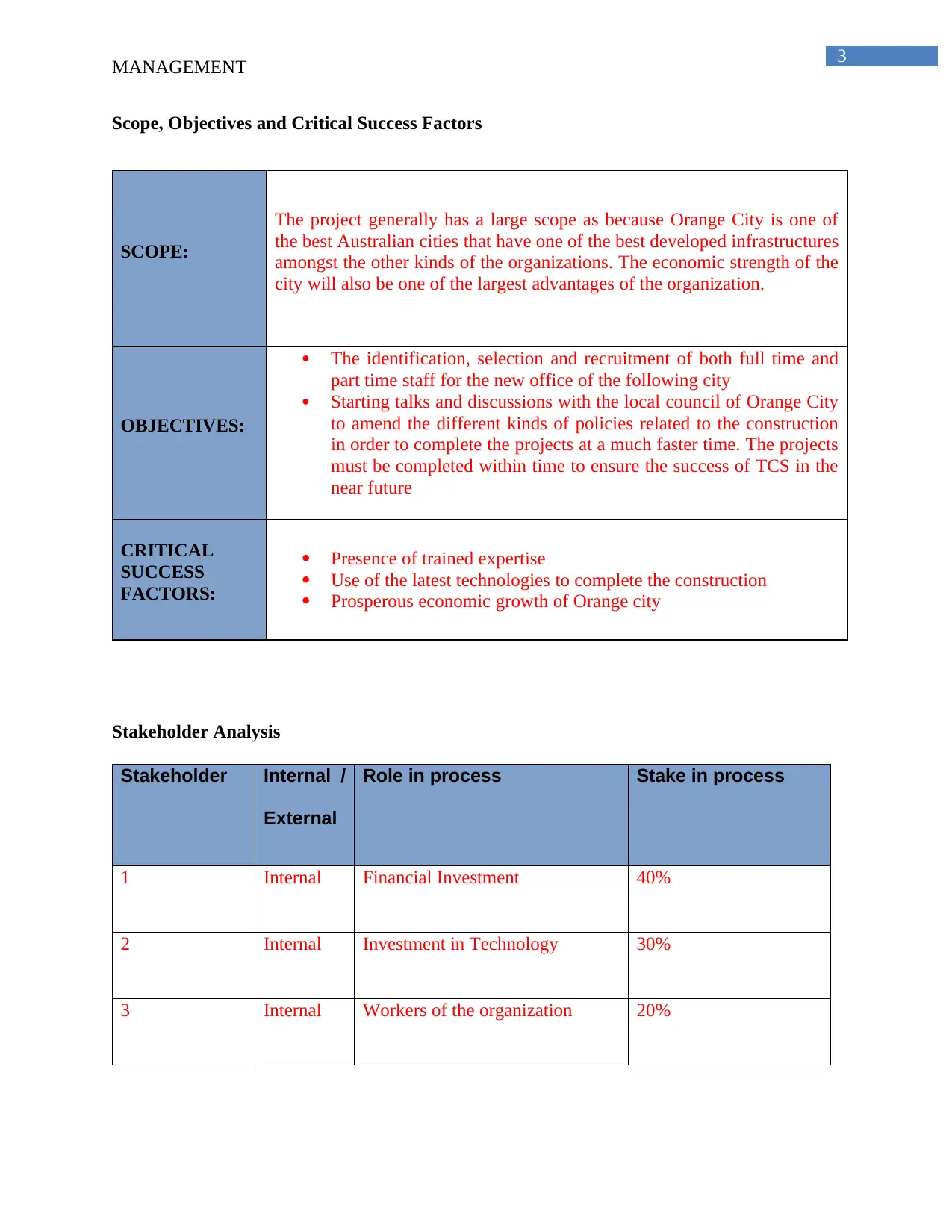
3
MANAGEMENT
Scope, Objectives and Critical Success Factors
SCOPE:
The project generally has a large scope as because Orange City is one of
the best Australian cities that have one of the best developed infrastructures
amongst the other kinds of the organizations. The economic strength of the
city will also be one of the largest advantages of the organization.
OBJECTIVES:
The identification, selection and recruitment of both full time and
part time staff for the new office of the following city
Starting talks and discussions with the local council of Orange City
to amend the different kinds of policies related to the construction
in order to complete the projects at a much faster time. The projects
must be completed within time to ensure the success of TCS in the
near future
CRITICAL
SUCCESS
FACTORS:
Presence of trained expertise
Use of the latest technologies to complete the construction
Prosperous economic growth of Orange city
Stakeholder Analysis
Stakeholder Internal /
External
Role in process Stake in process
1 Internal Financial Investment 40%
2 Internal Investment in Technology 30%
3 Internal Workers of the organization 20%
MANAGEMENT
Scope, Objectives and Critical Success Factors
SCOPE:
The project generally has a large scope as because Orange City is one of
the best Australian cities that have one of the best developed infrastructures
amongst the other kinds of the organizations. The economic strength of the
city will also be one of the largest advantages of the organization.
OBJECTIVES:
The identification, selection and recruitment of both full time and
part time staff for the new office of the following city
Starting talks and discussions with the local council of Orange City
to amend the different kinds of policies related to the construction
in order to complete the projects at a much faster time. The projects
must be completed within time to ensure the success of TCS in the
near future
CRITICAL
SUCCESS
FACTORS:
Presence of trained expertise
Use of the latest technologies to complete the construction
Prosperous economic growth of Orange city
Stakeholder Analysis
Stakeholder Internal /
External
Role in process Stake in process
1 Internal Financial Investment 40%
2 Internal Investment in Technology 30%
3 Internal Workers of the organization 20%
⊘ This is a preview!⊘
Do you want full access?
Subscribe today to unlock all pages.

Trusted by 1+ million students worldwide
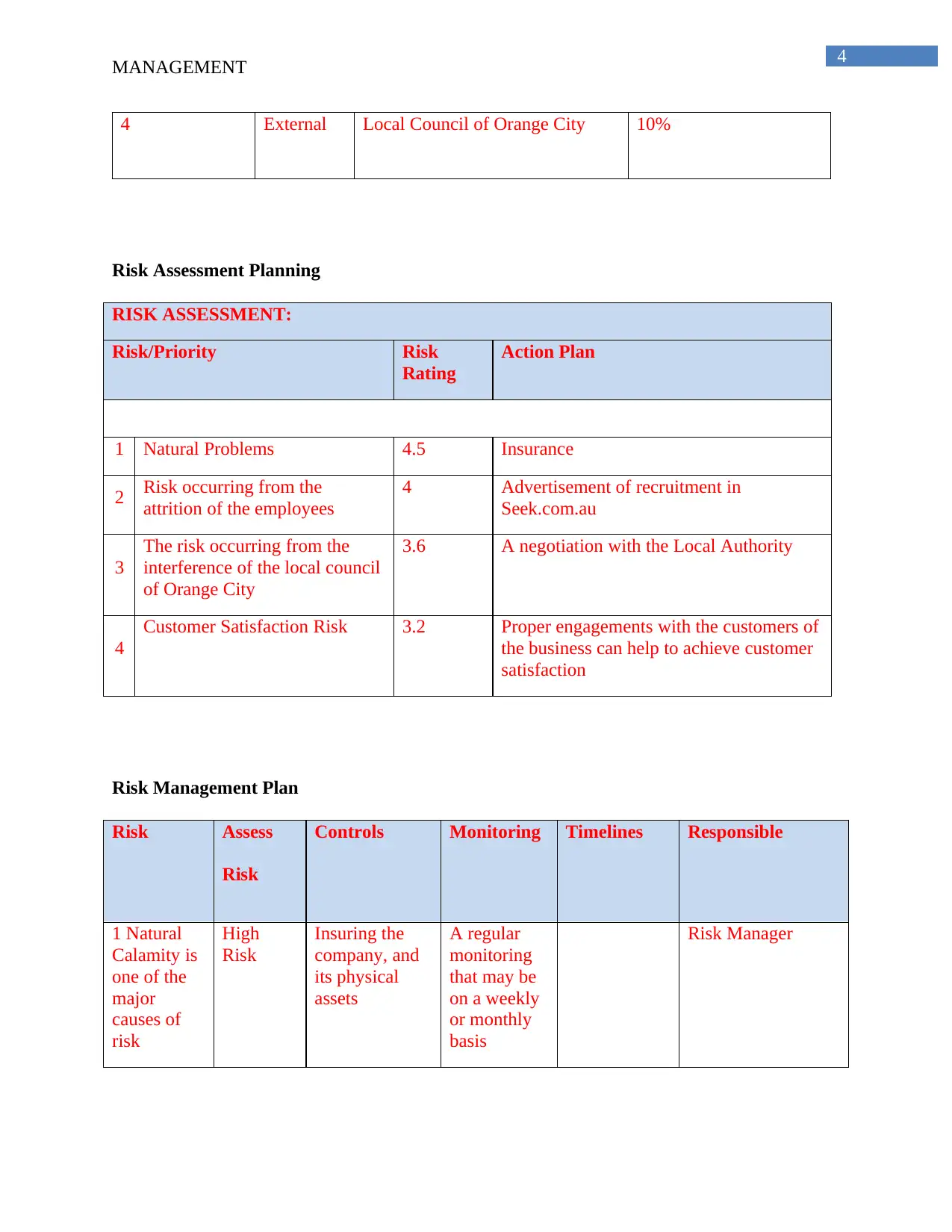
4
MANAGEMENT
4 External Local Council of Orange City 10%
Risk Assessment Planning
RISK ASSESSMENT:
Risk/Priority Risk
Rating
Action Plan
1 Natural Problems 4.5 Insurance
2 Risk occurring from the
attrition of the employees
4 Advertisement of recruitment in
Seek.com.au
3
The risk occurring from the
interference of the local council
of Orange City
3.6 A negotiation with the Local Authority
4
Customer Satisfaction Risk 3.2 Proper engagements with the customers of
the business can help to achieve customer
satisfaction
Risk Management Plan
Risk Assess
Risk
Controls Monitoring Timelines Responsible
1 Natural
Calamity is
one of the
major
causes of
risk
High
Risk
Insuring the
company, and
its physical
assets
A regular
monitoring
that may be
on a weekly
or monthly
basis
Risk Manager
MANAGEMENT
4 External Local Council of Orange City 10%
Risk Assessment Planning
RISK ASSESSMENT:
Risk/Priority Risk
Rating
Action Plan
1 Natural Problems 4.5 Insurance
2 Risk occurring from the
attrition of the employees
4 Advertisement of recruitment in
Seek.com.au
3
The risk occurring from the
interference of the local council
of Orange City
3.6 A negotiation with the Local Authority
4
Customer Satisfaction Risk 3.2 Proper engagements with the customers of
the business can help to achieve customer
satisfaction
Risk Management Plan
Risk Assess
Risk
Controls Monitoring Timelines Responsible
1 Natural
Calamity is
one of the
major
causes of
risk
High
Risk
Insuring the
company, and
its physical
assets
A regular
monitoring
that may be
on a weekly
or monthly
basis
Risk Manager
Paraphrase This Document
Need a fresh take? Get an instant paraphrase of this document with our AI Paraphraser
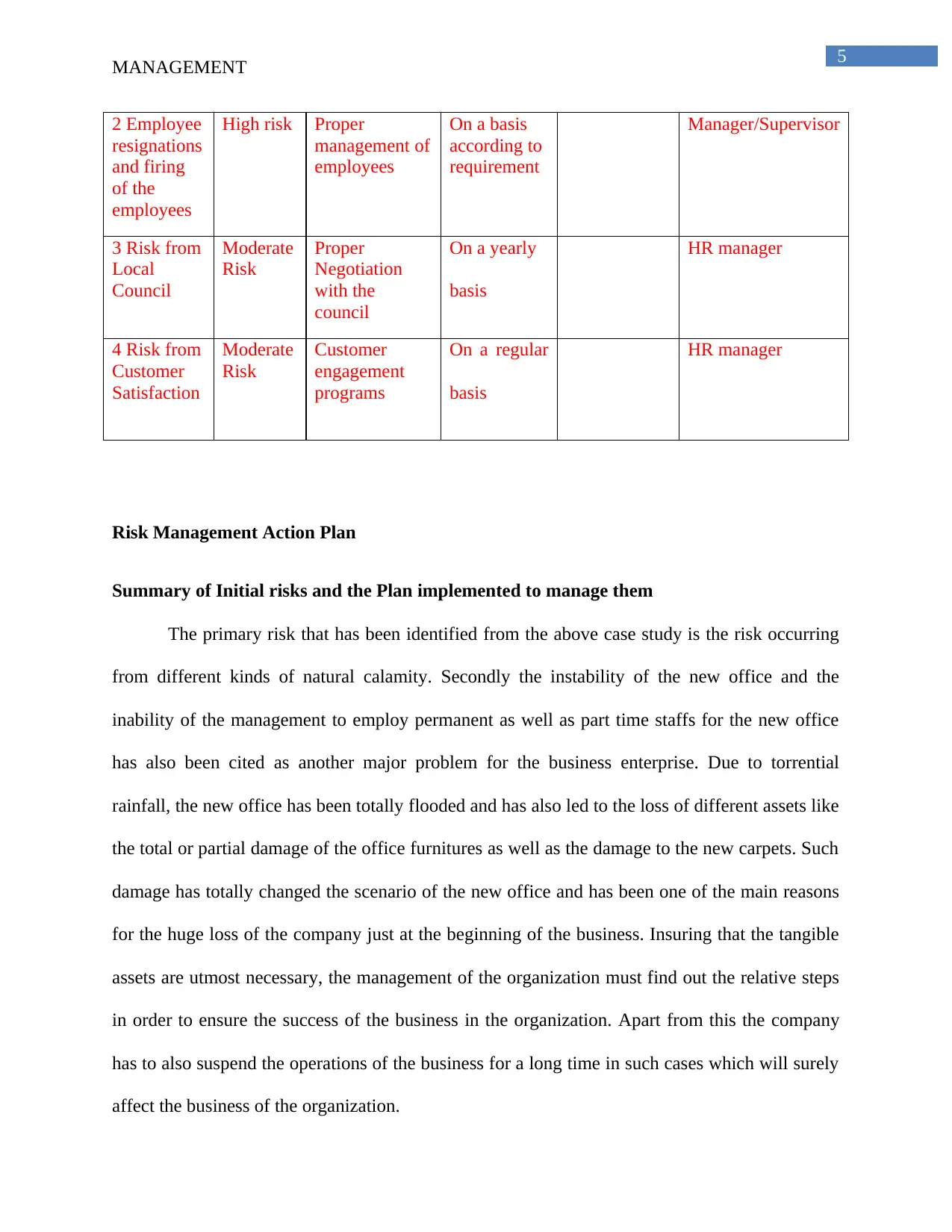
5
MANAGEMENT
2 Employee
resignations
and firing
of the
employees
High risk Proper
management of
employees
On a basis
according to
requirement
Manager/Supervisor
3 Risk from
Local
Council
Moderate
Risk
Proper
Negotiation
with the
council
On a yearly
basis
HR manager
4 Risk from
Customer
Satisfaction
Moderate
Risk
Customer
engagement
programs
On a regular
basis
HR manager
Risk Management Action Plan
Summary of Initial risks and the Plan implemented to manage them
The primary risk that has been identified from the above case study is the risk occurring
from different kinds of natural calamity. Secondly the instability of the new office and the
inability of the management to employ permanent as well as part time staffs for the new office
has also been cited as another major problem for the business enterprise. Due to torrential
rainfall, the new office has been totally flooded and has also led to the loss of different assets like
the total or partial damage of the office furnitures as well as the damage to the new carpets. Such
damage has totally changed the scenario of the new office and has been one of the main reasons
for the huge loss of the company just at the beginning of the business. Insuring that the tangible
assets are utmost necessary, the management of the organization must find out the relative steps
in order to ensure the success of the business in the organization. Apart from this the company
has to also suspend the operations of the business for a long time in such cases which will surely
affect the business of the organization.
MANAGEMENT
2 Employee
resignations
and firing
of the
employees
High risk Proper
management of
employees
On a basis
according to
requirement
Manager/Supervisor
3 Risk from
Local
Council
Moderate
Risk
Proper
Negotiation
with the
council
On a yearly
basis
HR manager
4 Risk from
Customer
Satisfaction
Moderate
Risk
Customer
engagement
programs
On a regular
basis
HR manager
Risk Management Action Plan
Summary of Initial risks and the Plan implemented to manage them
The primary risk that has been identified from the above case study is the risk occurring
from different kinds of natural calamity. Secondly the instability of the new office and the
inability of the management to employ permanent as well as part time staffs for the new office
has also been cited as another major problem for the business enterprise. Due to torrential
rainfall, the new office has been totally flooded and has also led to the loss of different assets like
the total or partial damage of the office furnitures as well as the damage to the new carpets. Such
damage has totally changed the scenario of the new office and has been one of the main reasons
for the huge loss of the company just at the beginning of the business. Insuring that the tangible
assets are utmost necessary, the management of the organization must find out the relative steps
in order to ensure the success of the business in the organization. Apart from this the company
has to also suspend the operations of the business for a long time in such cases which will surely
affect the business of the organization.
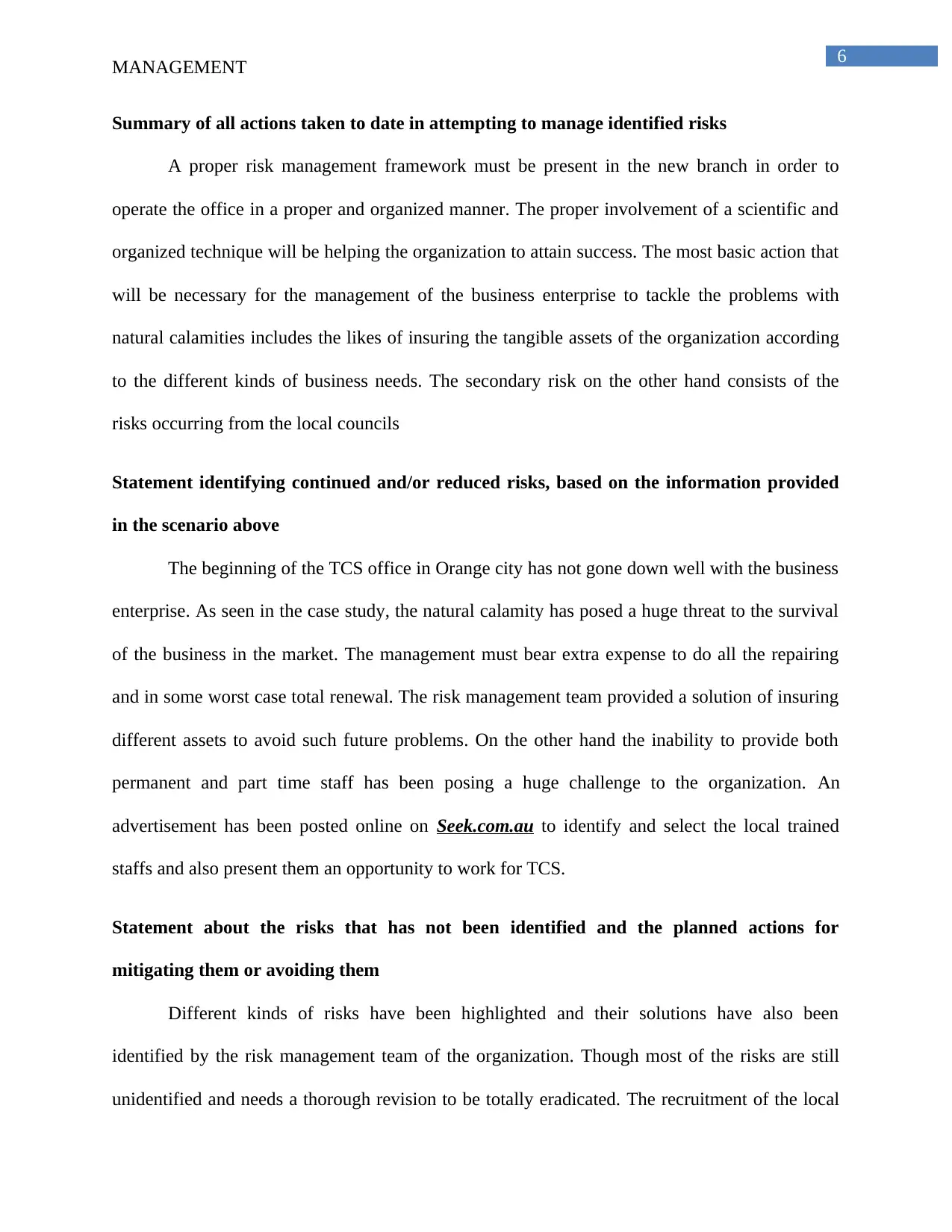
6
MANAGEMENT
Summary of all actions taken to date in attempting to manage identified risks
A proper risk management framework must be present in the new branch in order to
operate the office in a proper and organized manner. The proper involvement of a scientific and
organized technique will be helping the organization to attain success. The most basic action that
will be necessary for the management of the business enterprise to tackle the problems with
natural calamities includes the likes of insuring the tangible assets of the organization according
to the different kinds of business needs. The secondary risk on the other hand consists of the
risks occurring from the local councils
Statement identifying continued and/or reduced risks, based on the information provided
in the scenario above
The beginning of the TCS office in Orange city has not gone down well with the business
enterprise. As seen in the case study, the natural calamity has posed a huge threat to the survival
of the business in the market. The management must bear extra expense to do all the repairing
and in some worst case total renewal. The risk management team provided a solution of insuring
different assets to avoid such future problems. On the other hand the inability to provide both
permanent and part time staff has been posing a huge challenge to the organization. An
advertisement has been posted online on Seek.com.au to identify and select the local trained
staffs and also present them an opportunity to work for TCS.
Statement about the risks that has not been identified and the planned actions for
mitigating them or avoiding them
Different kinds of risks have been highlighted and their solutions have also been
identified by the risk management team of the organization. Though most of the risks are still
unidentified and needs a thorough revision to be totally eradicated. The recruitment of the local
MANAGEMENT
Summary of all actions taken to date in attempting to manage identified risks
A proper risk management framework must be present in the new branch in order to
operate the office in a proper and organized manner. The proper involvement of a scientific and
organized technique will be helping the organization to attain success. The most basic action that
will be necessary for the management of the business enterprise to tackle the problems with
natural calamities includes the likes of insuring the tangible assets of the organization according
to the different kinds of business needs. The secondary risk on the other hand consists of the
risks occurring from the local councils
Statement identifying continued and/or reduced risks, based on the information provided
in the scenario above
The beginning of the TCS office in Orange city has not gone down well with the business
enterprise. As seen in the case study, the natural calamity has posed a huge threat to the survival
of the business in the market. The management must bear extra expense to do all the repairing
and in some worst case total renewal. The risk management team provided a solution of insuring
different assets to avoid such future problems. On the other hand the inability to provide both
permanent and part time staff has been posing a huge challenge to the organization. An
advertisement has been posted online on Seek.com.au to identify and select the local trained
staffs and also present them an opportunity to work for TCS.
Statement about the risks that has not been identified and the planned actions for
mitigating them or avoiding them
Different kinds of risks have been highlighted and their solutions have also been
identified by the risk management team of the organization. Though most of the risks are still
unidentified and needs a thorough revision to be totally eradicated. The recruitment of the local
⊘ This is a preview!⊘
Do you want full access?
Subscribe today to unlock all pages.

Trusted by 1+ million students worldwide
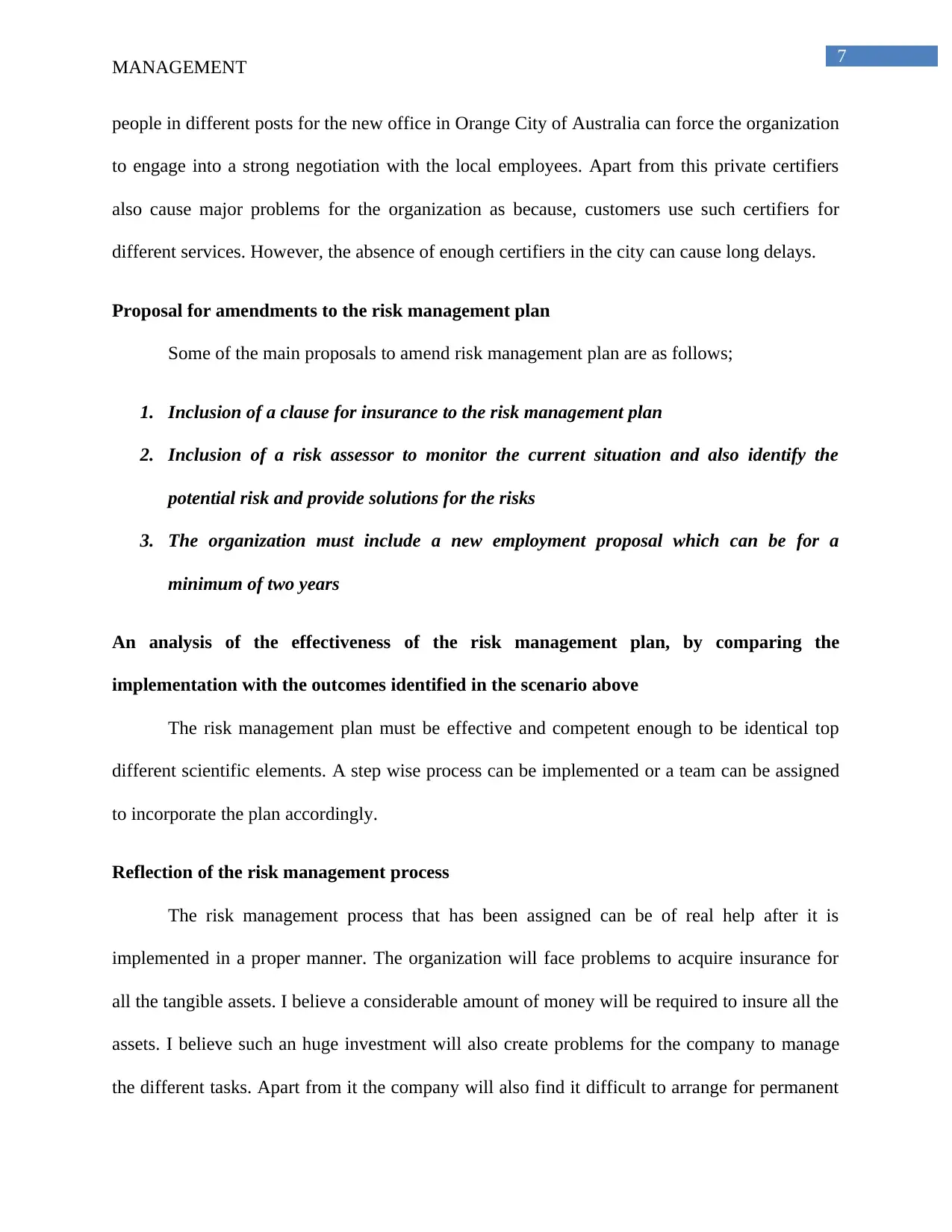
7
MANAGEMENT
people in different posts for the new office in Orange City of Australia can force the organization
to engage into a strong negotiation with the local employees. Apart from this private certifiers
also cause major problems for the organization as because, customers use such certifiers for
different services. However, the absence of enough certifiers in the city can cause long delays.
Proposal for amendments to the risk management plan
Some of the main proposals to amend risk management plan are as follows;
1. Inclusion of a clause for insurance to the risk management plan
2. Inclusion of a risk assessor to monitor the current situation and also identify the
potential risk and provide solutions for the risks
3. The organization must include a new employment proposal which can be for a
minimum of two years
An analysis of the effectiveness of the risk management plan, by comparing the
implementation with the outcomes identified in the scenario above
The risk management plan must be effective and competent enough to be identical top
different scientific elements. A step wise process can be implemented or a team can be assigned
to incorporate the plan accordingly.
Reflection of the risk management process
The risk management process that has been assigned can be of real help after it is
implemented in a proper manner. The organization will face problems to acquire insurance for
all the tangible assets. I believe a considerable amount of money will be required to insure all the
assets. I believe such an huge investment will also create problems for the company to manage
the different tasks. Apart from it the company will also find it difficult to arrange for permanent
MANAGEMENT
people in different posts for the new office in Orange City of Australia can force the organization
to engage into a strong negotiation with the local employees. Apart from this private certifiers
also cause major problems for the organization as because, customers use such certifiers for
different services. However, the absence of enough certifiers in the city can cause long delays.
Proposal for amendments to the risk management plan
Some of the main proposals to amend risk management plan are as follows;
1. Inclusion of a clause for insurance to the risk management plan
2. Inclusion of a risk assessor to monitor the current situation and also identify the
potential risk and provide solutions for the risks
3. The organization must include a new employment proposal which can be for a
minimum of two years
An analysis of the effectiveness of the risk management plan, by comparing the
implementation with the outcomes identified in the scenario above
The risk management plan must be effective and competent enough to be identical top
different scientific elements. A step wise process can be implemented or a team can be assigned
to incorporate the plan accordingly.
Reflection of the risk management process
The risk management process that has been assigned can be of real help after it is
implemented in a proper manner. The organization will face problems to acquire insurance for
all the tangible assets. I believe a considerable amount of money will be required to insure all the
assets. I believe such an huge investment will also create problems for the company to manage
the different tasks. Apart from it the company will also find it difficult to arrange for permanent
Paraphrase This Document
Need a fresh take? Get an instant paraphrase of this document with our AI Paraphraser

8
MANAGEMENT
staffs at the local office. However, the risk management plan needs to be incorporated in the
organization to ensure success.
MANAGEMENT
staffs at the local office. However, the risk management plan needs to be incorporated in the
organization to ensure success.
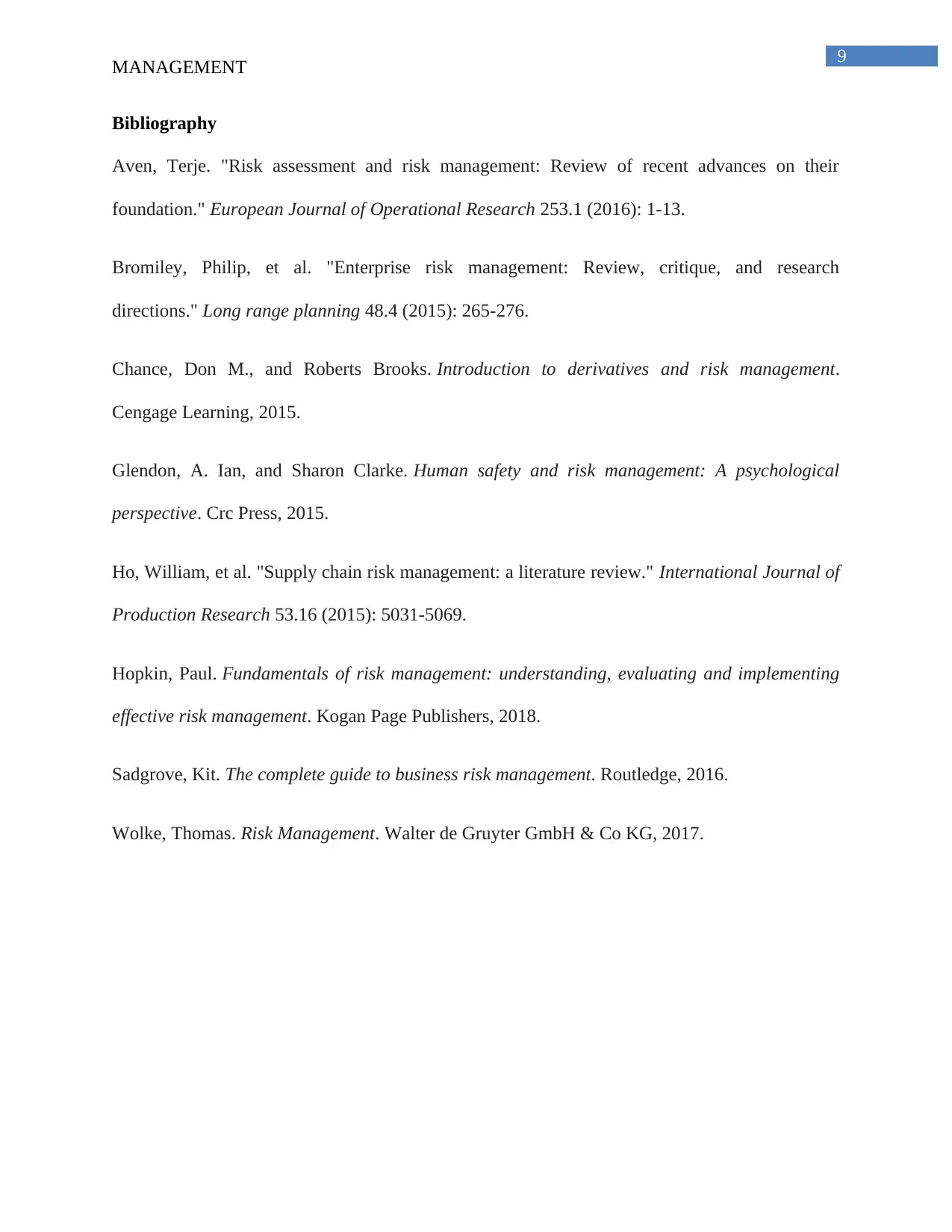
9
MANAGEMENT
Bibliography
Aven, Terje. "Risk assessment and risk management: Review of recent advances on their
foundation." European Journal of Operational Research 253.1 (2016): 1-13.
Bromiley, Philip, et al. "Enterprise risk management: Review, critique, and research
directions." Long range planning 48.4 (2015): 265-276.
Chance, Don M., and Roberts Brooks. Introduction to derivatives and risk management.
Cengage Learning, 2015.
Glendon, A. Ian, and Sharon Clarke. Human safety and risk management: A psychological
perspective. Crc Press, 2015.
Ho, William, et al. "Supply chain risk management: a literature review." International Journal of
Production Research 53.16 (2015): 5031-5069.
Hopkin, Paul. Fundamentals of risk management: understanding, evaluating and implementing
effective risk management. Kogan Page Publishers, 2018.
Sadgrove, Kit. The complete guide to business risk management. Routledge, 2016.
Wolke, Thomas. Risk Management. Walter de Gruyter GmbH & Co KG, 2017.
MANAGEMENT
Bibliography
Aven, Terje. "Risk assessment and risk management: Review of recent advances on their
foundation." European Journal of Operational Research 253.1 (2016): 1-13.
Bromiley, Philip, et al. "Enterprise risk management: Review, critique, and research
directions." Long range planning 48.4 (2015): 265-276.
Chance, Don M., and Roberts Brooks. Introduction to derivatives and risk management.
Cengage Learning, 2015.
Glendon, A. Ian, and Sharon Clarke. Human safety and risk management: A psychological
perspective. Crc Press, 2015.
Ho, William, et al. "Supply chain risk management: a literature review." International Journal of
Production Research 53.16 (2015): 5031-5069.
Hopkin, Paul. Fundamentals of risk management: understanding, evaluating and implementing
effective risk management. Kogan Page Publishers, 2018.
Sadgrove, Kit. The complete guide to business risk management. Routledge, 2016.
Wolke, Thomas. Risk Management. Walter de Gruyter GmbH & Co KG, 2017.
⊘ This is a preview!⊘
Do you want full access?
Subscribe today to unlock all pages.

Trusted by 1+ million students worldwide
1 out of 9
Related Documents
Your All-in-One AI-Powered Toolkit for Academic Success.
+13062052269
info@desklib.com
Available 24*7 on WhatsApp / Email
![[object Object]](/_next/static/media/star-bottom.7253800d.svg)
Unlock your academic potential
Copyright © 2020–2025 A2Z Services. All Rights Reserved. Developed and managed by ZUCOL.





